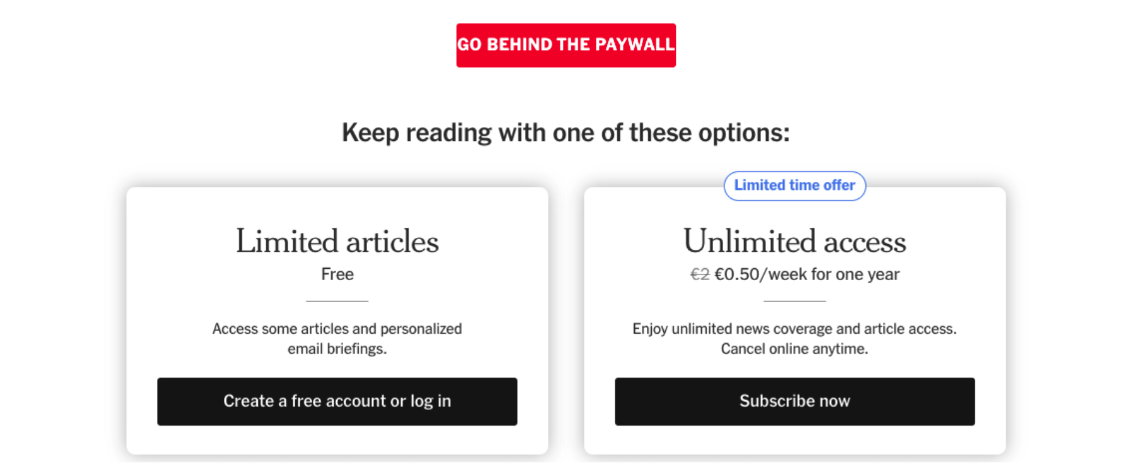
originally posted to www.carnsight.com
A friend sends you a link, you’re fact-checking some research, or a sparky headline grabs your attention. You click on the article, only to hit a dreaded paywall. It’s frustrating, especially when you’re looking for valuable information quickly. But while we might sigh and click away, it’s important to understand how paywalls fit into the modern media landscape. Especially when you work in PR like we do, and are always working to secure placements for clients in top-tier publications.
Oxford Universtiy’s Reuters Institute reports that more than two-thirds (69%) of leading newspapers across the UK, EU and US are operating some kind of online paywall. Hence, undoubtedly, this trend is shaping how we approach media and impacts the choices we make for our clients – so let’s unpack it.
Simply put, a paywall does exactly what it says on the tin – it erects a ‘wall’ to protect content and requires you to ‘pay’ for it to be removed. It’s a digital gate that monetises content that will restrict access to either the majority or entirely of a webpage unless payment is made to remove the wall.
Paywalls come in several forms:

The media’s argument for instituting paywalls is generally built on the idea that they give an opportunity for news outlets to turn a profit without relying on digital advertising. For these outlets, paywalls and their subscribers therefore serve as an alternative profit source and diversified revenue stream. In theory, this shift can be beneficial in maintaining journalistic integrity, as publications may feel less pressured to cater to advertisers’ interests and rely less on their funding to stay afloat. However, this shift can alienate some readers, as many are accustomed to free access to information. Especially in this day and age, following the mass democratisation of television, radio, social media, and hundreds of thousands of online platforms and news sources.
These days, many of us still pay for a magazine or print newspaper here and there. We hardly balk at the notion of adding a media subscription or two to our monthly bills so that we can keep up to date with our favourite tv shows and films. Our music may come to us via Spotify, Apple or Amazon with a regular payment.
So why is there often backlash when it comes to applying a similar model to our news? And why are we so reluctant?
According to the 2022 Reuters Institute Digital News Report, only about 5% of British consumers are prepared to pay for an online news subscription. This discrepancy may come down to perceived value and the abundance of free alternatives. If we can get news from TV, radio, free websites, or social media channels like TikTok and Instagram, it’s natural to question why we’d pay for another source. Free platforms provide instant, accessible news and often cover similar stories, making it harder to justify the expense. So many of us may then think, why bother paying for someone else to tell us much of the same thing?
Our best answer to that is the access to higher quality and accuracy. We like to think of the ‘best’ paywalls as supporting in-depth, well-researched pieces. For publications that use their paywalls in this way, we PRs see it as an advantage when clients are featured in these articles. Content isn’t being hidden – it’s being funnelled in front of a selection of people who are interested in quality reporting, and are willing to pay to see and/or support it. They’re more invested than your average reader, will likely pay more attention, and view the article as more reputable. Hence, for PR pros, understanding paywall dynamics and focusing efforts on respected paywall sites can align clients with quality content, supporting brand credibility.
Of course, different paywalls reflect different motivations. Like I said earlier – many publications argue that subscriptions help support independent, unbiased journalism. Without needing to appeal as heavily to advertisers, publications can focus on producing balanced reporting and quality investigative work. They can afford to employ the best people and retain top tier talent. Some outlets, however, are transparent that paywalls are vital to keeping the lights on, and that’s it. Some see it as a sustainable business measure. Others a profit driven.
At the end of 2023, a Reuters Institute study found that long-term news subscribers tend to be older, wealthier, better educated, and have a strong interest in news and politics. They are also more willing to support journalism financially and value a higher-quality, ad-free experience. In contrast, younger audiences may show support through occasional donations rather than subscriptions.
Subscribers are drawn to paywall sites for their distinctive, high-quality content, curated and exclusive reporting, and identification with reputable news brands. By targeting clients’ messaging in these channels, PR professionals can reach audiences who place value on trusted, premium content – a potentially powerful demographic.
Paywalls are not going anywhere, and understanding their role can help PR professionals like us make more informed media choices. By aligning clients with respected paywall publications, we support their positioning in high-quality, reliable journalism channels. Paywalls remind us that the best content often comes at a cost, but for many audiences, that cost translates to trust, quality, and authority. For clients, this can mean more meaningful engagement with their message and brand.
So, next time a paywall stops you in your tracks, remember its purpose. Paywalls, for better or worse, are shaping modern media – and as PR pros, we’re part of that evolution.
At Carnsight Communications we create strategies and campaigns to showcase our clients’ brilliant work through PR, content and social media. We help them get noticed by the right audience, at the right time. We specialise in creative agency PR.
You need to load content from reCAPTCHA to submit the form. Please note that doing so will share data with third-party providers.
More Information